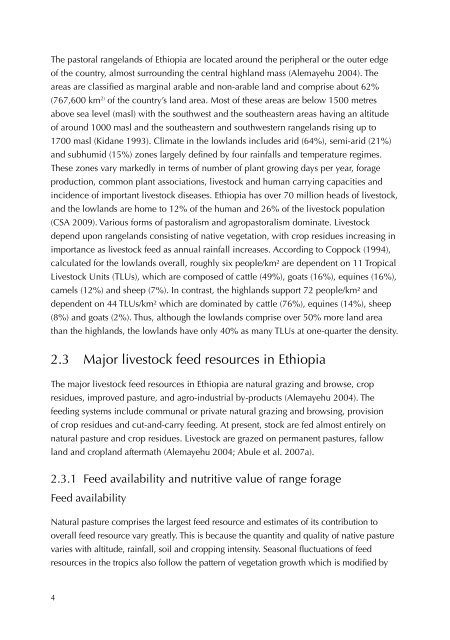Rangeland condition and feed resources in Metema District, North ...
Rangeland condition and feed resources in Metema District, North ...
Rangeland condition and feed resources in Metema District, North ...
Create successful ePaper yourself
Turn your PDF publications into a flip-book with our unique Google optimized e-Paper software.
The pastoral rangel<strong>and</strong>s of Ethiopia are located around the peripheral or the outer edge<br />
of the country, almost surround<strong>in</strong>g the central highl<strong>and</strong> mass (Alemayehu 2004). The<br />
areas are classified as marg<strong>in</strong>al arable <strong>and</strong> non-arable l<strong>and</strong> <strong>and</strong> comprise about 62%<br />
(767,600 km 2) of the country’s l<strong>and</strong> area. Most of these areas are below 1500 metres<br />
above sea level (masl) with the southwest <strong>and</strong> the southeastern areas hav<strong>in</strong>g an altitude<br />
of around 1000 masl <strong>and</strong> the southeastern <strong>and</strong> southwestern rangel<strong>and</strong>s ris<strong>in</strong>g up to<br />
1700 masl (Kidane 1993). Climate <strong>in</strong> the lowl<strong>and</strong>s <strong>in</strong>cludes arid (64%), semi-arid (21%)<br />
<strong>and</strong> subhumid (15%) zones largely def<strong>in</strong>ed by four ra<strong>in</strong>falls <strong>and</strong> temperature regimes.<br />
These zones vary markedly <strong>in</strong> terms of number of plant grow<strong>in</strong>g days per year, forage<br />
production, common plant associations, livestock <strong>and</strong> human carry<strong>in</strong>g capacities <strong>and</strong><br />
<strong>in</strong>cidence of important livestock diseases. Ethiopia has over 70 million heads of livestock,<br />
<strong>and</strong> the lowl<strong>and</strong>s are home to 12% of the human <strong>and</strong> 26% of the livestock population<br />
(CSA 2009). Various forms of pastoralism <strong>and</strong> agropastoralism dom<strong>in</strong>ate. Livestock<br />
depend upon rangel<strong>and</strong>s consist<strong>in</strong>g of native vegetation, with crop residues <strong>in</strong>creas<strong>in</strong>g <strong>in</strong><br />
importance as livestock <strong>feed</strong> as annual ra<strong>in</strong>fall <strong>in</strong>creases. Accord<strong>in</strong>g to Coppock (1994),<br />
calculated for the lowl<strong>and</strong>s overall, roughly six people/km² are dependent on 11 Tropical<br />
Livestock Units (TLUs), which are composed of cattle (49%), goats (16%), equ<strong>in</strong>es (16%),<br />
camels (12%) <strong>and</strong> sheep (7%). In contrast, the highl<strong>and</strong>s support 72 people/km² <strong>and</strong><br />
dependent on 44 TLUs/km² which are dom<strong>in</strong>ated by cattle (76%), equ<strong>in</strong>es (14%), sheep<br />
(8%) <strong>and</strong> goats (2%). Thus, although the lowl<strong>and</strong>s comprise over 50% more l<strong>and</strong> area<br />
than the highl<strong>and</strong>s, the lowl<strong>and</strong>s have only 40% as many TLUs at one-quarter the density.<br />
2.3 Major livestock <strong>feed</strong> <strong>resources</strong> <strong>in</strong> Ethiopia<br />
The major livestock <strong>feed</strong> <strong>resources</strong> <strong>in</strong> Ethiopia are natural graz<strong>in</strong>g <strong>and</strong> browse, crop<br />
residues, improved pasture, <strong>and</strong> agro-<strong>in</strong>dustrial by-products (Alemayehu 2004). The<br />
<strong>feed</strong><strong>in</strong>g systems <strong>in</strong>clude communal or private natural graz<strong>in</strong>g <strong>and</strong> brows<strong>in</strong>g, provision<br />
of crop residues <strong>and</strong> cut-<strong>and</strong>-carry <strong>feed</strong><strong>in</strong>g. At present, stock are fed almost entirely on<br />
natural pasture <strong>and</strong> crop residues. Livestock are grazed on permanent pastures, fallow<br />
l<strong>and</strong> <strong>and</strong> cropl<strong>and</strong> aftermath (Alemayehu 2004; Abule et al. 2007a).<br />
2.3.1 Feed availability <strong>and</strong> nutritive value of range forage<br />
Feed availability<br />
Natural pasture comprises the largest <strong>feed</strong> resource <strong>and</strong> estimates of its contribution to<br />
overall <strong>feed</strong> resource vary greatly. This is because the quantity <strong>and</strong> quality of native pasture<br />
varies with altitude, ra<strong>in</strong>fall, soil <strong>and</strong> cropp<strong>in</strong>g <strong>in</strong>tensity. Seasonal fluctuations of <strong>feed</strong><br />
<strong>resources</strong> <strong>in</strong> the tropics also follow the pattern of vegetation growth which is modified by<br />
4

















